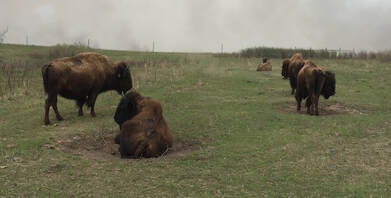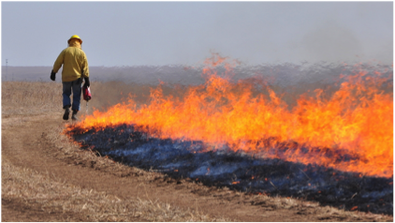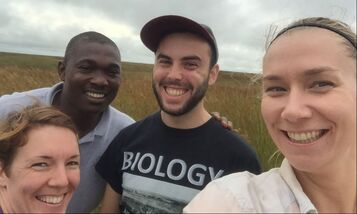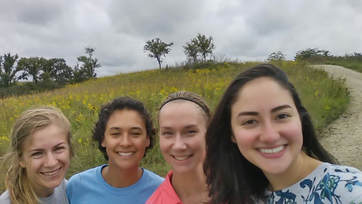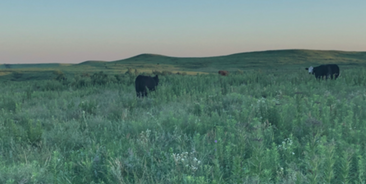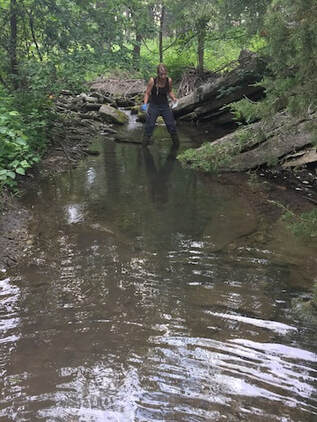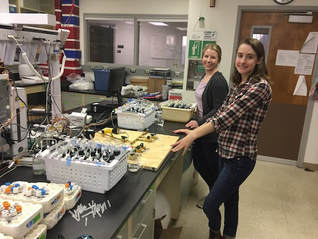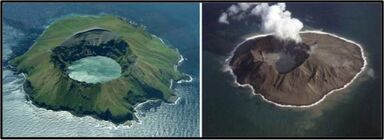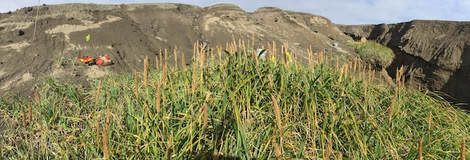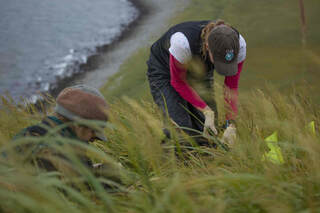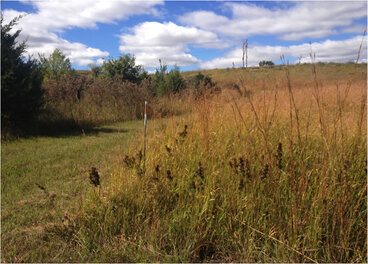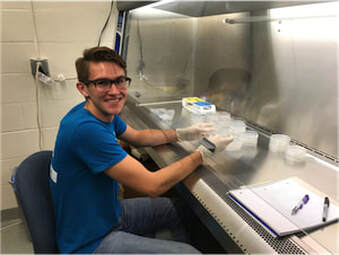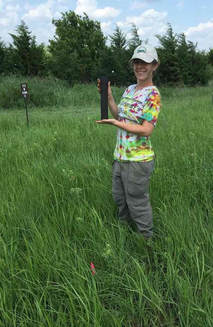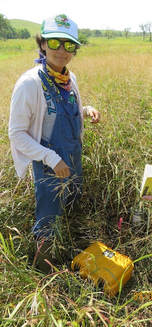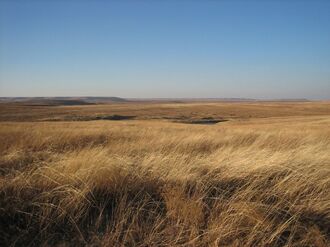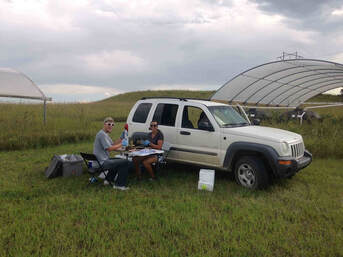|
People include Noortje (Agronomy), Edwin (Agronomy), Kent (Biology), lhz; CC (Biology), Priscilla (Biology), lhz, Priscila (Biology). Above that, Dr. A. Hope; above that, several of the resident Konza Prairie bison (with smoke in the background from prescribed fire in a nearby watershed); and at bottom, happy cows & calves on the patch-burn grazed Konza Prairie watersheds at sunset. **picture credit
|
|
Stream ecosystem function
|
That's Dr. Burgin's lab at KU in the lower picture, and our super-techs, Janaye (KSU) and Emma (KU). Janaye is hunting biofilms in a Kings Creek pool above.
|
|
Kasatochi Island before and after; a patch of Leymus mollis that has vegetatively recovered (supporting a much higher abundance, diversity and activity of soil microbes in the ash below, and more organic matter); lhz and CC working at the reference site on Adak Island. Thanks to the Alaska Maritime National Wildlife Refuge for being so supportive of young scientists who carry as much soil away with them as possible! The Aleutians are stark and beautiful.
|
Recovery of soil microbial structure and function post-volcanic eruptionKasatochi Volcano erupted in 2008, burying previously lush Kasatochi Island, Alaska in pyroclastic material. Since, communities of plants, animals and microbes have re-established on certain areas of this new surface, and a multi-disciplinary team of USGS, USFWS and academic scientists is studying this recovery. Volcanism shaped the Aleutian Islands, and results to date suggest the regional biota is resilient to this high- magnitude disturbance.
Microbial colonization of the new surface is directly linked to organic matter inputs - seabird deposition, plant regrowth, aeolian redistribution of pre-eruptive soil. "Recovery" of the soil microbial structure and function has been rapid (~5y), but slower accumulation of organic matter may limit whole system recovery. It is still not clear whether these recovery responses represent regional microbial dynamics, or are uniquely localized patterns. The Aleutian Islands have a mild climate, highly productive vegetation (it's a temperate rain-grassland!)... this creates potential for rapid soil organic matter accumulation though plant growth and high regional microbial dispersal potential due to big weather and seabird populations. |
Past projects
|
BGPE (top): guess which treatment hasn't been burned for >30y?
Other pics show CC and a root ingrowth core, Priscilla and the LiCor for belowground CO2 flux, Matt working to isolate bacteria from the soil. |
|
woody encroachment effects on soil carbon cycling
Woody plants are replacing grasses across the Great Plains, and in many other grassy ecosystems globally. The deeper-rooted shrubs deliver new carbon into the soil profile. (1) Will this input stimulate decomposition or carbon storage? (2) Will the whole ecosystem carbon balance change?
Our collaborative project (DOE.pdf) will answer these questions using new empirical data of soil C stocks and cycling activity profiles in native tallgrass prairie and woody-invaded prairie (picture to right), experiments to assess priming potential in these soils, including at depth, and most exciting, use of these data in updated earth systems models that include plant cover change and drought impacts in their predictive capacity. Drought is increasing across the globe, and woody plants also pull more water from depth. This could have important feedbacks on both vegetation change and carbon storage, particularly in high-clay soils of this region (note color change at depth in the pictured core). |
In the late 1970's, these watersheds (above) looked the same. Since then, one was burned annually (left) and one was burned twice (right). The consequent woody encroachment could change soil carbon dynamics (1-m core below, top to right of rotated picture), and the whole ecosystem carbon balance.
|
|
|
Microbial turnover & stress responses to intensified drought in Grassland soilsGlobal change models predict that Great Plains soils will experience longer periods of drying and larger re-wetting events in the future. While altered precipitation does impact microbial function, many prairie soil microbiota are tolerant to the stress of drought. Understanding the mechanisms driving stress tolerance, and the prevalence of these traits in native and agricultural soils, will help in predicting and preparing for the future.
We ran lab experiments that showed greater taxon-specific sensitivity (death) through dry-down/re-wet cycles in soils with a history of less drought, which was also associated with more soil C loss. Also, we evlauated how a simulated "megadrought" affects microbiota in situ in soils with different drought histories. This work was done in collaboration with investigators on the Rainfall Manipulation Plots (RaMPs, at right). |
Konza Prairie at top. This is Nature Conservancy land managed by the K-State Konza Prairie Biological Station, that hosts many projects, including some of ours. Thanks to Dr. Hartnett for letting us use his Jeep Liberty (Sean and Victoria sieving)!
|
|
* thanks to Roger Topp for the amazing pictures of the Aleutians. I took some, but the ones that look really good are his :)
** thanks to Barb Van Slyke for the man-make-fire picture. She also has some superior photography skills.
** thanks to Barb Van Slyke for the man-make-fire picture. She also has some superior photography skills.
Updated December 2023
